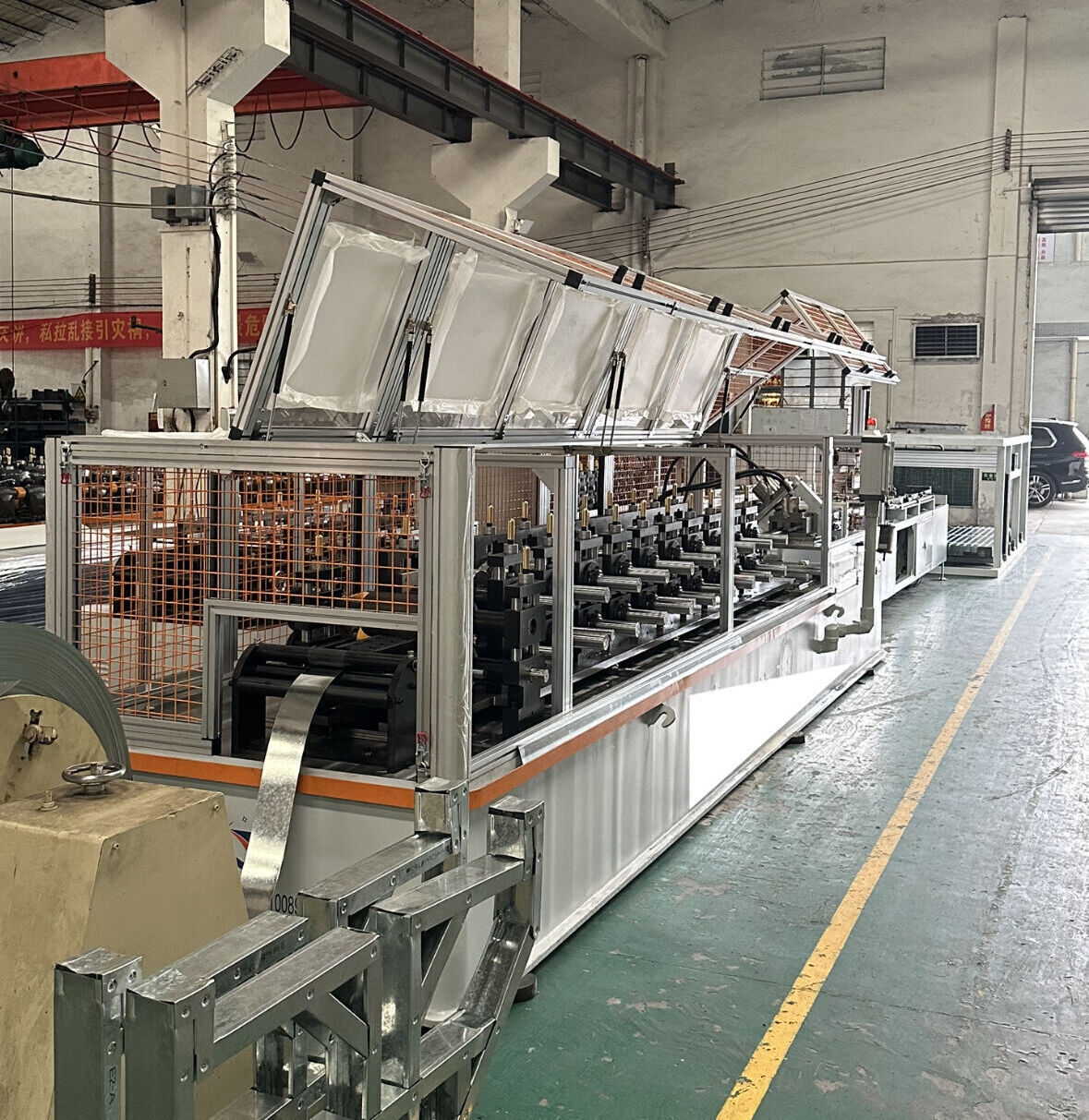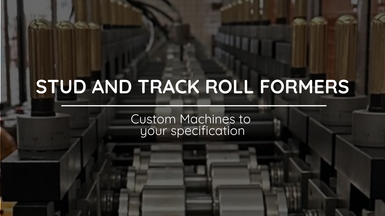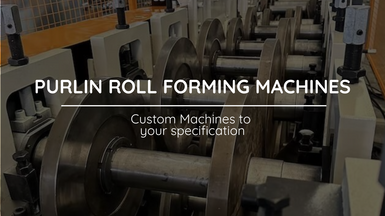
Metal C Channel Roll Forming Machine
Here's how a typical Metal C Channel Roll Forming Machine works:
Posted on Monday, November 20, 2023
A Metal C Channel Roll Forming Machine is a specialized piece of equipment used in the manufacturing and construction industry to produce C-shaped or U-shaped metal channels from flat metal coils or sheets. These channels are commonly used as structural components in various applications, such as building frames, support structures, and industrial equipment.
Here's how a typical Metal C Channel Roll Forming Machine works:
- Material Loading: The process begins with loading a coil or sheet of metal, typically steel or aluminum, onto the machine. The material is usually fed from a coil holder or decoiler.
- Material Straightening: Before entering the roll forming section, the metal strip may pass through rollers or leveling devices to ensure it is straight and uniform.
- Roll Forming: The heart of the machine is the roll forming section, where a series of specially designed rollers progressively bend and shape the metal strip into the desired C-shaped or U-shaped channel profile. These rollers are strategically arranged, with each successive roller performing a specific bending or shaping operation. The number and design of rollers can vary based on the final channel profile and size.
- Cutting: Once the metal strip has been fully formed into the C-channel shape, a cutting mechanism is employed to trim the channel to the required length. This can be done using various methods, including flying cutoff shears or stationary dies.
- Quality Control: Some roll forming machines may include sensors or quality control devices to monitor the dimensions and quality of the channels produced. This ensures that the final products meet the required specifications.
- Stacking or Packaging: After cutting, the finished C-channels are typically stacked, bundled, or packaged for transportation and further processing.
Key advantages of using a Metal C Channel Roll Forming Machine include:
- High Efficiency: Roll forming is a continuous process that can produce C-channels at a high rate, making it a cost-effective manufacturing method.
- Customization: Roll forming machines can be configured to produce C-channels with various dimensions, profiles, and materials to meet specific project requirements.
- Precision and Consistency: Roll forming offers precise control over the shape and dimensions of the channels, resulting in consistent and accurate products.
- Reduced Material Waste: The roll forming process minimizes material waste compared to other manufacturing methods.
- Versatility: These machines can be adapted for various applications beyond C-channels, including producing other profiles like Z-channels, hat channels, and more.
Metal C Channel Roll Forming Machines are commonly used in the construction, automotive, aerospace, and manufacturing industries. They play a crucial role in producing structural components and various building materials.
C Channel Profile
A C-channel profile, also known as a C-beam or a C-section, is a type of structural steel profile with a cross-sectional shape resembling the letter "C." It is widely used in construction and various structural applications to provide support, framing, and reinforcement. C-channel profiles come in various sizes, dimensions, and thicknesses, and they can be made from different materials, with steel and aluminum being common choices.
The basic design of a C-channel profile consists of a flat horizontal top section and two vertical legs that extend downward at a right angle from the top section. The two vertical legs are of equal length and are parallel to each other. The top section, or flange, is wider than the legs, which provides stability and strength.
C-channel profiles are used for a wide range of applications, including:
- Structural Support: C-channels are often used as structural beams, joists, or purlins in buildings and bridges. They provide support and distribute loads across a structural framework.
- Frame Construction: They are commonly used in the construction of frames for doors, windows, and cabinets, as well as in the assembly of equipment and machinery frames.
- Conveyor Systems: C-channel profiles can serve as the base or support structure for conveyor systems used in manufacturing and material handling.
- Solar Panel Mounting: C-channels are used to create the framework for mounting solar panels on rooftops or in solar farms.
- Automotive Industry: In the automotive industry, C-channels are used in vehicle frames and chassis construction to provide strength and rigidity.
- Electrical and Cable Management: C-channel profiles are used for cable trays, raceways, and conduit support in electrical installations.
- Signage and Billboards: They are employed to create the frames and support structures for large signs and billboards.
C-channel profiles come in a variety of sizes, and their dimensions are specified by their height (measured from the top of the flange to the bottom of the legs), width (the width of the top flange), and thickness. The choice of C-channel size depends on the specific load-bearing requirements of the application.
It's important to note that C-channel profiles are just one type of structural steel profile, and there are many other profiles with different cross-sectional shapes, such as I-beams (also known as H-beams), U-channels, and Z-channels, each designed for specific structural purposes. The choice of profile depends on the structural and load-bearing needs of a particular project
C Channel Sizes
C-channel sizes can vary widely depending on the specific requirements of a project, the material used (commonly steel or aluminum), and regional standards. C-channel profiles are typically defined by their dimensions, including height, width, and thickness. Here are some common C-channel sizes with approximate dimensions:
- Standard C-Channel Sizes:
- Height (H): Typically ranges from 3 inches (75 mm) to 12 inches (300 mm) or more.
- Width (W): Usually varies from 1.5 inches (38 mm) to 4 inches (100 mm) or more.
- Thickness (T): Common thicknesses include 0.125 inches (3.18 mm), 0.1875 inches (4.76 mm), 0.25 inches (6.35 mm), and 0.375 inches (9.53 mm), among others.
- Metric C-Channel Sizes:
- In some regions, metric C-channel profiles are used, and the dimensions are specified in millimeters.
- Metric C-channels often have height and width dimensions ranging from 50 mm to 300 mm or more, with corresponding thicknesses.
- Light-Duty vs. Heavy-Duty:
- Light-duty C-channels are typically smaller in size and thickness and are often used for lighter applications like framing cabinets or shelving.
- Heavy-duty C-channels are larger and thicker, suitable for structural support and construction projects.
- Custom Sizes:
- In addition to standard sizes, C-channels can be custom-produced to meet specific project requirements. The dimensions can be tailored to fit the load-bearing needs of the application.
It's important to note that the availability of C-channel sizes may vary by region and manufacturer, and specific industry standards or regulations may dictate certain size requirements for structural applications. Therefore, when selecting C-channel sizes for a project, it's essential to consult with structural engineers, architects, or suppliers to ensure that the chosen profiles meet the required load-bearing and design specifications.
Additionally, the material used (e.g., carbon steel, stainless steel, aluminum) and the surface finish (e.g., galvanized, plain, or coated) can also influence the performance and appearance of C-channel profiles. The choice of material and finish should align with the environmental and corrosion resistance requirements of the application.
All our machines are all due to variations in the customer's demand, and we are always ready to assist with any issues. All machines are assembled by our expert team in Orlando, Florida. We have been leading the Roll Forming Machine market since 2009, and have great expertise, so you will be in safe hands. For further information, contact our team here.
For more Machines, browse our extensive range here
Roll Forming Machines LLC's New Factory
Posted on Sunday, March 23, 2025
We have relocated factories, which will be available for tours very soon.

Uncoiler, Decoiler and Coil Car Roll Forming Machine Accesories from Roll Forming Machines LLC
Posted on Sunday, November 24, 2024
Contact us today with your specifications for a custom Uncoiler, Decoiler or Coil Car at [email protected] or call us at (+1) (407) 859 1119

Stud and Track Roll Forming Machines from Roll Forming Machines LLC
Posted on Saturday, November 23, 2024
Contact us today with your specifications for a custom Stud and Track Machine at [email protected] or call us at (+1) (407) 859 1119

Cee and Zee Purlin Roll Forming Machines from Roll Forming Machines LLC
Posted on Saturday, November 23, 2024
Contact us today with your specifications for a custom Cee and Zee Purlin Machine at [email protected] or call us at (+1) (407) 859 1119